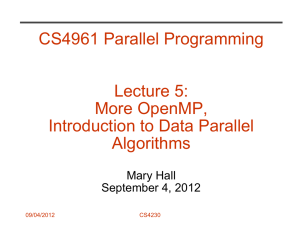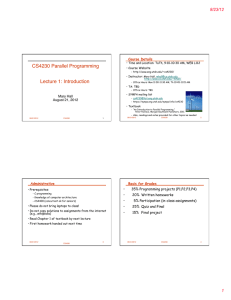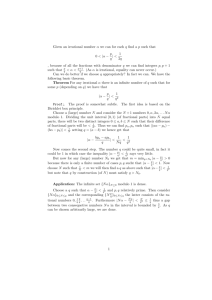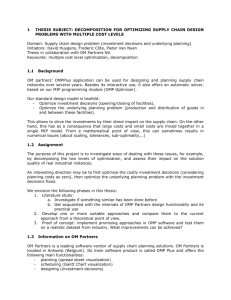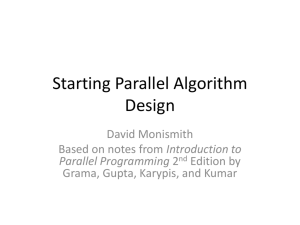CS4230 Parallel Programming Lecture 7: Loop Scheduling cont., and Data Dependences
advertisement
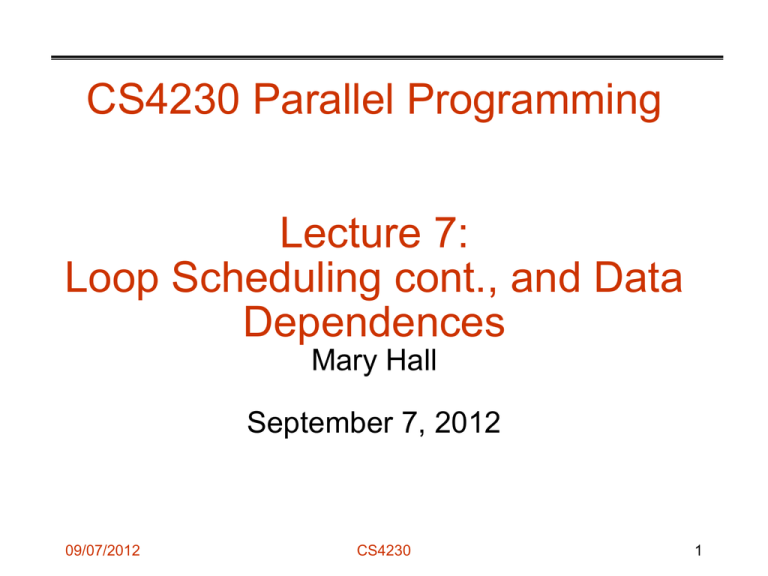
CS4230 Parallel Programming
Lecture 7:
Loop Scheduling cont., and Data
Dependences
Mary Hall
September 7, 2012
09/07/2012
CS4230
1
Administrative
• I will be on travel on Tuesday, September 11
• There will be no lecture
• Instead, you should watch the following two videos:
- “Intro to Parallel Programming . Lesson 3, pt. 1 - Implementing Domain
Decompositons with OpenMP”, by Clay Breshears, Intel,
http://www.youtube.com/watch?v=9n1b9Uwvgaw&feature=relmfu (9:53),
reinforces OpenMP data parallelism
- “Dense Linear Algebra” by Jim Demmel, CS237 at UC Berkeley,
http://www.youtube.com/watch?v=2pFOivcJ74g&feature=relmfu (start at
18:15 until 30:40), establishes bounds of dense linear algebra performance,
taking parallelism and locality into account
- There will be a quiz on this material on Thursday, September 13 (participation
grade)
09/07/2012
CS4230
2
Homework 2: Mapping to Architecture
Due before class, Thursday, September 6
Objective: Begin thinking about architecture mapping issues
Turn in electronically on the CADE machines using the handin program:
“handin cs4230 hw2 <probfile>”
•Problem 1: (2.3 in text) [Locality]
•Problem 2: (2.8 in text) [Caches and multithreading]
•Problem 3: [Amdahl’s Law] A multiprocessor consists of 100 processors, each
capable of a peak execution rate of 20 Gflops. What is performance of the
system as measured in Gflops when 20% of the code is sequential and 80% is
parallelizable?
•Problem 4: (2.16 in text) [Parallelization scaling]
•Problem 5: [Buses and crossbars] Suppose you have a computation that uses
two vector inputs to compute a vector output, where each vector is stored in
consecutive memory locations. Each input and output location is unique, but
data is loaded/stored from cache in 4-word transfers. Suppose you have P
processors and N data elements, and execution time is a function of time L for
a load from memory and time C for the computation. Compare parallel
execution time for a shared memory architecture with a bus (Nehalem)versus
a full crossbar (Niagara) from Lecture 3, assuming a write back cache that is
larger than the data footprint.
09/07/2012
CS4230
3
Programming Assignment 1:
Due Friday, Sept. 14, 11PM MDT
To be done on water.eng.utah.edu (you all have accounts – passwords
available if your CS account doesn’t work)
1.Write a program to calculate π in OpenMP for a problem size and
data set to be provided. Use a block data distribution.
2.Write the same computation in Pthreads.
Report your results in a separate README file.
- What is the parallel speedup of your code? To compute parallel
speedup, you will need to time the execution of both the
sequential and parallel code, and report
speedup =
Time(seq) / Time (parallel)
- If your code does not speed up, you will need to adjust the
parallelism granularity, the amount of work each processor does
between synchronization points. You can do this by either
decreasing the number of threads or increasing the number of
iterations.
- Report results for two different # of threads, holding
iterations fixed, and two different # of iterations holding
threads fixed. Also report lines of code for the two solutions.
Extra credit: Rewrite both codes using a cyclic distribution and
measure performance for same configurations.
09/07/2012
CS4230
4
Programming Assignment 1, cont.
• A test harness is provided in pi-test-harness.c that
provides a sequential pi calculation, validation, speedup
timing and substantial instructions on what you need to do
to complete the assignment.
• Here are the key points:
- You’ll need to write the parallel code, and the things needed to
support that. Read the top of the file, and search for “TODO”.
- Compile w/ OpenMP: cc –o pi-openmp –O3 –xopenmp pi-openmp.c
- Compile w/ Pthreads:
cc –o pi-pthreads –O3 pi-pthreads.c –lpthread
- Run OpenMP version: ./pi-openmp > openmp.out
- Run Pthreads version: ./pi-pthreads > pthreads.out
• Note that editing on water is somewhat primitive – I’m
using vim. You may want to edit on a different CADE
machine.
09/07/2012
CS4230
5
Estimating π
09/07/2012
CS4230
6
Today’s Lecture
• OpenMP parallel, parallel for and for
constructs from last time
• OpenMP loop scheduling demonstration
• Data Dependences
- How compilers reason about them
- Formal definition of reordering transformations
that preserve program meaning
- Informal determination of parallelization safety
• Sources for this lecture:
- Notes on website
09/07/2012
CS4230
7
OpenMP Sum Examples: Improvement
Last time (sum v3):
Improved, posted (sum v3):
int sum, mysum[64];
int sum, mysum[64];
sum = 0;
sum = 0;
#pragma omp parallel
#pragma omp parallel
{
{
int my_id = omp_get_thread_num(); int my_id = omp_get_thread_num();
mysum[my_id] = 0;
mysum[my_id] = 0;
}
#pragma omp parallel for
#pragma omp for
for (i=0; i<size; i++) {
for (i=0; i<size; i++) {
int my_id = omp_get_thread_num();
mysum[my_id] += _iplist[i];
mysum[my_id] += _iplist[i];
}
}
#pragma omp parallel {
#pragma omp critical
int my_id = omp_get_thread_num();
sum += mysum[my_id];
#pragma omp critical
}
sum += mysum[my_id];
return sum;
}
return sum;
09/07/2012
CS4230
8
Common Data Distributions
• Consider a 1-Dimensional array to solve the global sum
problem, 16 elements, 4 threads
CYCLIC (chunk = 1) (version 2):
for (i = 0; i<blocksize; i++)
… in [i*blocksize + tid];
3
6
7
5
3
5
6
2
9
1
2
7
0
9
3
6
BLOCK (chunk = 4) (default, version 1):
for (i=tid*blocksize; i<(tid+1) *blocksize; i++)
… in[i];
3
6
7
5
3
5
6
2
9
1
2
7
0
9
3
6
7
0
9
3
6
BLOCK-CYCLIC (chunk = 2) (version 3):
3
6
7
09/07/2012
5
3
5
6
2
9
CS4230
1
2
9
The Schedule Clause
• Default schedule:
• Cyclic schedule:
09/07/2012
CS4230
10
OpenMP environment variables
OMP_NUM_THREADS
sets the number of threads to use during execution
when dynamic adjustment of the number of threads is enabled, the
value of this environment variable is the maximum number of
threads to use
For example,
setenv OMP_NUM_THREADS 16 [csh, tcsh]
export OMP_NUM_THREADS=16 [sh, ksh, bash]
OMP_SCHEDULE (version 4)
applies only to do/for and parallel do/for directives that
have the schedule type RUNTIME
sets schedule type and chunk size for all such loops
For example,
setenv OMP_SCHEDULE GUIDED,4 [csh, tcsh]
export OMP_SCHEDULE= GUIDED,4 [sh, ksh, bash]
09/07/2012
CS4230
11
Race Condition or Data Dependence
• A race condition exists when the result of an
execution depends on the timing of two or
more events.
• A data dependence is an ordering on a pair of
memory operations that must be preserved to
maintain correctness.
09/07/2012
CS4230
12
Key Control Concept: Data Dependence
• Question: When is parallelization guaranteed to be
safe?
• Answer: If there are no data dependences across
reordered computations.
• Definition: Two memory accesses are involved in a
data dependence if they may refer to the same
memory location and one of the accesses is a write.
• Bernstein’s conditions (1966): Ij is the set of
memory locations read by process Pj, and Oj the set
updated by process Pj. To execute Pj and another
process Pk in parallel,
Ij ∩ Ok = ϕ
write after read
Ik ∩ Oj = ϕ
read after write
Oj ∩ Ok = ϕ
write after write
09/07/2012
CS4230
13
Data Dependence and Related Definitions
• Actually, parallelizing compilers must formalize this to guarantee
correct code.
• Let’s look at how they do it. It will help us understand how to reason
about correctness as programmers.
• Definition:
Two memory accesses are involved in a data dependence if they may
refer to the same memory location and one of the references is a
write.
A data dependence can either be between two distinct program
statements or two different dynamic executions of the same program
statement.
• Source:
• “Optimizing Compilers for Modern Architectures: A Dependence-Based
Approach”, Allen and Kennedy, 2002, Ch. 2.
09/07/2012
CS4230
14
Data Dependence of Scalar Variables
True (flow) dependence
a
Anti-dependence
a
Output dependence
a
a
=
=a
=a
=
=
=
Input dependence (for locality)
=a
=a
Definition: Data dependence exists from a reference
instance i to i’ iff
either i or i’ is a write operation
i and i’ refer to the same variable
i executes before i’
09/07/2012
CS4230
15
Some Definitions (from Allen & Kennedy)
• Definition 2.5:
- Two computations are equivalent if, on the same inputs,
- they produce identical outputs
- the outputs are executed in the same order
• Definition 2.6:
- A reordering transformation
- changes the order of statement execution
- without adding or deleting any statement executions.
• Definition 2.7:
- A reordering transformation preserves a dependence if
- it preserves the relative execution order of the dependences’
source and sink.
16
09/07/2012
CS4230
Fundamental Theorem of Dependence
• Theorem 2.2:
- Any reordering transformation that preserves
every dependence in a program preserves the
meaning of that program.
17
09/07/2012
CS4230
In this course, we consider two kinds of reordering
transformations
• Parallelization
- Computations that execute in parallel between
synchronization points are potentially reordered. Is
that reordering safe? According to our definition, it is
safe if it preserves the dependences in the code.
• Locality optimizations
- Suppose we want to modify the order in which a
computation accesses memory so that it is more likely
to be in cache. This is also a reordering
transformation, and it is safe if it preserves the
dependences in the code.
• Reduction computations
- We have to relax this rule for reductions. It is safe to reorder
reductions for commutative and associative operations.
09/07/2012
CS4230
18
How to determine safety of reordering
transformations
• Informally
- Must preserve relative order of dependence source and sink
- So, cannot reverse order
• Formally
- Tracking dependences
- A simple abstraction: Distance vectors
09/07/2012
CS4230
19
Brief Detour on Parallelizable Loops as a
Reordering Transformation
Forall or Doall loops:
Loops whose iterations can execute in parallel (a particular
reordering transformation)
Example
Meaning?
forall (i=1; i<=n; i++)
A[i] = B[i] + C[i];
Each iteration can execute independently of others
Free to schedule iterations in any order (e.g., pragma omp forall)
Source of scalable, balanced work
Common to scientific, multimedia, graphics & other domains
09/07/2012
CS4230
20
Data Dependence for Arrays
LoopCarried
dependence
for (i=2; i<5; i++)
A[i] = A[i-2]+1;
for (i=1; i<=3; i++)
A[i] = A[i]+1;
LoopIndependent
dependence
• Recognizing parallel loops (intuitively)
- Find data dependences in loop
- No dependences crossing iteration boundary
parallelization of loop’s iterations is safe
21
09/07/2012
CS4230

